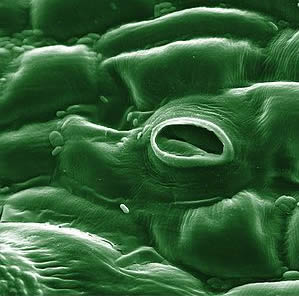Transpiration
Transpiration is the evaporation of water from the aerial parts of plants, especially leaves but also stems, flowers and roots. Leaf surfaces are dotted with openings called stoma that are bordered by guard cells. Collectively, the structures are called stomata. Leaf transpiration occurs through stomata, and can be as a necessary "cost" associated with many processes such as the opening of the pistil and allowing the diffusion of carbon dioxide gas from the air for photosynthesis. Transpiration also cools plants and enables mass flow of mineral nutrients and water from roots to shoots.Mass flow is caused by the decrease in hydrostatic (water) pressure in the upper parts of the plants due to the diffusion of water out of stomata into the atmosphere. Water is absorbed at the roots by osmosis, and any dissolved mineral nutrients travel with it through the xylem.
The rate of transpiration is directly related to the degree of stomatal opening, and to the evaporative demand of the atmosphere surrounding the leaf. The amount of water lost by a plant depends on its size, along with the surrounding light intensity, temperature, humidity, and wind speed (all of which influence evaporative demand). Soil water supply and soil temperature can influence stomatal opening, and thus transpiration rate.
A fully grown tree may lose several hundred gallons (a few cubic meters) of water through its leaves on a hot, dry day. About 90% of the water that enters a plant's roots is used for this process. The transpiration ratio is the ratio of the mass of water transpired to the mass of dry matter produced; the transpiration ratio of crops tends to fall between 200 and 1000 (i.e., crop plants transpire 200 to 1000 kg of water for every kg of dry matter produced).
Transpiration rate of plants can be measured by a number of techniques, including potometers, lysimeters, porometers, and heat balance sap flow gauges.
Desert plants and conifers have specially adapted structures, such as thick cuticles, reduced leaf areas, sunken stomata and hairs to reduce transpiration and conserve water. Many cacti conduct photosynthesis in succulent stems, rather than leaves, so the surface area of the shoot is very low. Many desert plants have a special type of photosynthesis, termed Crassulacean acid metabolism or CAM photosynthesis in which the stomata are closed during the day and open at night when transpiration will be lower.
About 90% of the water that enters the plants roots is used for transpiration.
References
- Benjamin Cummins (2007), Biological Science (3 ed.), Freeman, Scott, p. 215- Martin, J.; W. Leonard & D. Stamp (1976), Principles of Field Crop Production (Third Edition), New York: Macmillan Publishing Co., Inc.





